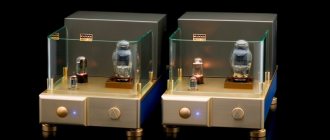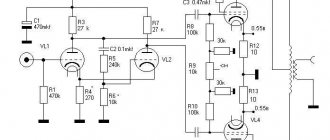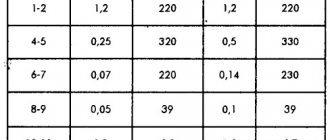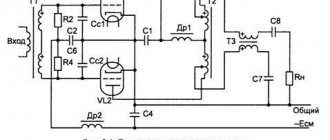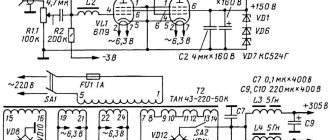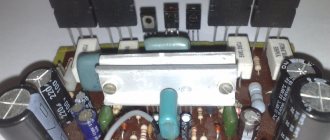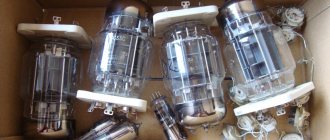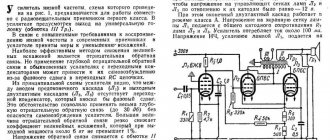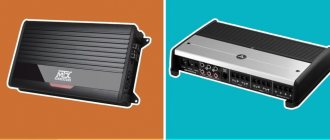Personally, I would not make this heating device. Lots of heat, lots of sound, lots of everything. An acquaintance of my eldest son, having listened to my 6C4C amplifier at home, *lit up* with tube sound, and asked to make *Magnepanov* for him. Strange Acoustics, low sensitivity, this is unacceptable for a light bulb, well, it’s necessary, then it’s necessary, the choice fell on 6C33C. 12 watts, class A, I asked for the same acoustics in the store for wiretapping, played with the layout, mostly shunt capacitors, since the circuit is classic, from Tolya Manakov, no need to be tricky.
Tolya, thank you!!!!!!!!!!!!
About the driver lamp. The question is, of course, interesting. Even earlier, my now deceased friend Sasha Belkanov (editor-in-chief of the beloved A.R.A. magazine) tried to find a formula with this same driver lamp. What did he not crossbreed it with? As a result, his idea remained unfulfilled. It seems that we sinners cannot handle this either. However, we are not discouraged and are trying to find some solution. Personally, I have tried various numbers of lamps for this purpose. Here are 6S4S and EL-34 and 6P3S-E and 6N6P and 6N1P and 6N23P And much more, but I stopped (for this purpose) at 6P14P in a triode. I really liked it because of its neutrality, balance throughout the entire band and works well with transformer loads. And, then, it is a very sound lamp.
On 1. About cathodes. Of course, two. On 2. About modes. Many years of practice have shown that for this lamp, Ua = 200 V, Ia = 200 mA are better in all respects. Vladimir Starodubtsev
Burtsev's recommendations In general, experiments with this lamp led to the following results. According to 6С33С (6П45С)……. In normal military lamps, the grid is covered with gold. Gold is a material with a high work function. And there is no significant avalanche-like growth of secondary emissions from grid overheating. In the shitty ones, they are coated with nickel or something else. Under normal operating modes, this “PRACTICALLY” does not affect the operating parameters of the lamp BUT, as soon as the driver puts the lamp into the “working with grid currents” modes (secondary emission is formed between the grid and the anad) ... the grid heats up, the emission increases ... as a result, even more heats up - grows like an avalanche until an arc forms and the lamp burns out. That’s why the old, thoroughly military GU50s work without such avalanche-like separation, up to a dark crimson color and overheating, but they don’t burn out….. And 6P45S, already television grids without gilding, burn out as the anode current floats away.
It's the same story with 6S33S. Initially, the lamp was only for the military and was produced at the Leningrad Svetlana... And it definitely had a gilded mesh coating. Then, in the mid-70s, production was transferred to the Ulyanovsk plant (where many generator lamps were made), but since the military order was already much smaller, the technological reserve standards were also greatly reduced, which made it possible to slightly change the materials and abandon the gilding of the mesh... .. The same story happened with our Novosibirsk 6P27S... they play even better than the EL34... but not for long) they saved a little gold on the grid, the vacuum is crap... The grid gets clogged with all sorts of crap from the cathode (this is where the imperfection of the vacuum manifests itself and the savings on material))) and in in the end, it also ends its life by overheating the mains and an avalanche-like increase in secondary emissions......
It’s no coincidence that my friend has a single-cycle 6S33S-EVDR with a bunch of military acceptance marks and he doesn’t know such problems at all. In general, the idea is this - lamps up to the mid-70s and only Svetlanov ones... I wish they had a native passport, where the precious metals are indicated and you can see the amount of gold in the product))) But it is almost impossible to find them OR to look for ways to prevent such things and insure against self-dispersal. There is an option with one heating, then the lamp operates in a very light thermal mode and, accordingly, does not burn out. Of course, in such modes she would have to remove all the characteristics again, and you could lose all the thrill of a 15-watt otnotaktnik. There is such a 6С41С lamp, which is half of a 6С33С, but it was stuffed into a small cylinder, the voltage is very high and the limiting modes are limited precisely by this fact - the lamp cannot dissipate the required heat and it really turns out not to be a 6С33С rug... In general, there is no happiness in life. But the identical version 6С41С is not our way. As I understand it, when 300V is used in modes close to the limit, then with lamps from “some” manufacturers (and a scoop is a scoop - we save on everything) the same thing happens. The lamps do not last long for precisely the same reason - over time, due to poor vacuum and (or) insufficient work function of the grid coating material, that same avalanche-like increase in thermal emission from the grid to the anode occurs... the anode current increases... an arc is formed between the anode and the grid and the lamp triode turns into the diode)))))) Therefore, WE work without problems, and some do not work for long. And someone solved this problem in their own way... not everyone can spend a couple of thousand bucks on WE light bulbs)) So, turning to Alexey Burtsev (NEM), I received recommendations on how to use their bias circuit (and interstage) for this case. Alexey’s recommendations: “In the bias for 6S33S, use our bias circuit for 300V. Just replace the variable resistor with a nominal value of 1K with 220 ohms (type PPZ-41 - they are three-watt) and 4.7K with 470 ohms with a power of 10 watts, and the constant 1K should be used for power 15–20 watts. The alternating voltage of the secondary winding for the cross-section must be such as to provide a current through these resistors at 100 mA. This will allow you to have a total leakage resistance for 6С33С equal to the sum of 220 + 470 + secondary interstage trans, i.e. less than 1K and the adjustment range from 47V to 69V. Sincerely, A.B.” The bigger picture is there. Further more…. You can of course use 6E5P…. but some dog breeders recommend 7-8 grid biases to power the driver, and in general, getting a swing of 55-70 volts on one lamp is not a trivial task... there are not many such lamps - but there is an option to use 6P14P in a tricky connection from Vladimir Perepelkin. Or use 6:52G or half of 6F12P or 6E5P.
To be continued... criticism and additions are welcome.
Let me explain in more detail. If you set the 6C33C to trans on 1 com, then as a rule there are no problems with the dynamics. If you want to achieve high CD values and make a load of, for example, 2 kohms, then you begin to feel a lack of dynamics and bass. This problem is solved by increasing the supply capacity approximately FOUR-FOUR. The dependence is quadratic: Ra is doubled, capacities are quadrupled; three times – nine times, etc.
I tested this experimentally - by ear.
From here it becomes clear why Yuri Makarov uses such capacitance values in his amplifiers. His amplifiers have no problems with dynamics Shalin
I took Ri 150 ohms based on their mode, which I often use for the 33rd: 260 V, 220 mA. Shalin
I am not a supporter of such schemes. All of them are somehow boring and, at best, sound monotonous after some time. Of all the variants of the usa on the 33rd with two cathodes, I admit that there were not many of them, the best sounded was Manakov’s circuit with a 6E5P driver, but all these designs, taken together, sounded, if you can call it that, if not disgusting - transistor, it’s simply disgusting, even mine with 6F12P. Judging by the current-voltage characteristics with one cathode it will be more linear and better. Even to the point that it is better to parallelize the matched halves in different cylinders than in one. If we proceed from what they write in books and what Messrs. Rubtsov and Burtsev wrote about, then for the 33rd in full inclusion it is difficult and expensive to make winding ones. It’s easier and cheaper to take another lamp, or stay with half of it. The simpler the circuit, the greater the requirements for the elements. And “circuit gardens” in sound are a dead-end option, with the exception of servo devices. Best regards, Arkady
For five years he operated a single-cycle on a 6S33S. Since I did not put output power and sensitivity in the first place, the modes were more than gentle: Epit = 135V, Ia = 360mA, Ucm = -30V (fixed), Rrass = 45W. But we must not forget that it is precisely in such modes that the lamp operates in the most linear mode and its Ri is close to the minimum (and, as a consequence, Rout). The sound is very good, although the power is 7W, but that’s what suits everyone. There have never been any problems with the anode current of the 6S33S (like floating). Efremovich
6S18S differs only in its larger anode area; unlike 6S33S, it does not have vertical holes in the middle between the two triodes in the electrode system. Shalin
Yeah, and an internal passport resistance of 80 ohms, a kind of record changer. Against passport 6S33S 120 ohms. Unfortunately, much fewer of them were produced, but the quality is amazing, even the old sagging 6S18S pleases the ear more than, say, a brand new 6S33S from the 70s - 80s. Evgeniy 073
First of all, 6S18S are good because most of them were from Svetlanov. And there the lamps were prepared well. According to Ri, not everything is so rosy. My 6S33S-V had approximately 5–10% less internal resistance than conventional 6S33S and Svetlanov 6S18S. This, however, did not improve their sound. Shalin
By the way, we forgot the 6S18S lamps - the predecessors of the 33s... - So their “curvature” is at the level of the 41s, probably this ultimately led to the creation of the 33s with a “hole” in the anode (maybe something overheated?)…
A. Nikitin.
As for stability... Still, no matter how many people claim that there is no difference between 6С33С and 6С33С-В, nevertheless, there is one. The latter proved to be an order of magnitude more stable. It is the “non-indexed” lamps that are easier to overclock. Gribko Victor&Nikolai
> In general, lamps 6S33S, 6S41S and 6S19P are... how to say, not the best choice for an amateur
> after-sounds and reverberations.
Exactly the same opinion, they are all quite “oaky” There is only one joy from them - a little Ri. Imho, shamanic dances with intensity will not help much here...
Again, imho, from this list probably the minimum oak is 1/2 6С33С, i.e. turned on at one heat. The sound is far from the same as the 6S41C, although in terms of parameters the half of the 33rd and the 41st are quite close.
Paralleled 2-3 pieces of 6S19P are also far from a gift. Besides, I really don’t like paralleling lamps - no matter how you choose them, it will still (to a greater or lesser extent) be a “choir named after Tyapnitsky” L0ki
